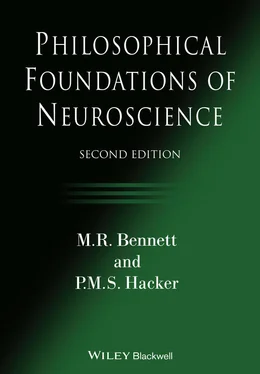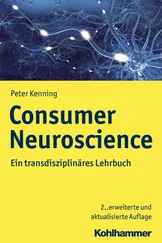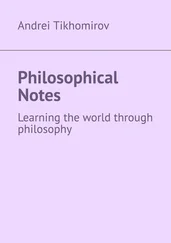1 ...6 7 8 10 11 12 ...47 Science is no more immune to conceptual error and confusion than any other form of intellectual endeavour. The history of science is littered with the debris of theories that were not simply factually mistaken, but conceptually awry. Stahl’ s theory of combustion, for example, was conceptually flawed in ascribing, in certain circumstances, negative weight to phlogiston – an idea that made no sense within its framework of Newtonian physics. Einstein’ s famous criticisms of the theory of electromagnetic aether (the alleged medium by which light was thought to be propagated) were directed not only at the results of the Michelson–Morley experiment, which had failed to detect any effect of absolute motion, but also at a conceptual confusion concerning relative motion involved in the role ascribed to aether in the explanation of electromagnetic induction. Neuroscience has been no exception – as we show in our historical survey. It is true enough that the subject is now a flourishing science. But that does not render it immune to conceptual confusions and entanglements. Newtonian kinematics was a flourishing science, but that did not stop Newton from becoming entangled in conceptual confusions over the intelligibility of action at a distance, or from bafflement (not remedied until Hertz) over the nature of force. So too, Sherrington’ s towering achievement in explaining the integrative action of synapses in the spinal cord, and thereby eliminating, once and for all, the confused idea of a ‘spinal soul’, was perfectly compatible with conceptual confusions concerning the ‘cerebral soul’ or mind and its relation to the brain. Similarly, Penfield’ s extraordinary achievements in identifying functional localization in the cortex, as well as in developing brilliant neurosurgical techniques, were perfectly compatible with extensive confusions about the relation between the mind and the brain and about the ‘highest brain function’ (an idea borrowed from Hughlings Jackson).
In short, conceptual entanglement can coexist with flourishing science. This may appear puzzling. If the science can flourish despite such conceptual confusions, why should scientists care about them? Hidden reefs do not imply that the seas are not navigable, only that they are dangerous. The moot question is how running on these reefs is manifest. Conceptual confusions may be exhibited in different ways and at different points in the investigation. In some cases, the conceptual unclarity may affect neither the cogency of the questions nor the fruitfulness of the experiments, but only the understanding of the results of the experiments and their theoretical implications. So, for example, Newton embarked on the Optics in quest of insight into the character of colour. The research was a permanent contribution to science. But his conclusion that ‘colours are sensations in the sensorium’ demonstrates failure to achieve the kind of understanding he craved. For, whatever colours are, they are not ‘sensations in the sensorium’. So in so far as Newton cared about understanding the results of his research, then he had good reason for caring about the conceptual confusions under which he laboured – for they stood in the way of an adequate understanding.
In other cases, however, the conceptual confusion does not so happily bracket the empirical research. Misguided questions may well render research futile (examples will be examined in relation to mental imagery (§6.3.1 [§7.3.1]) and voluntary movement (§8.2 [§9.2])). Rather differently, misconstrual of concepts and conceptual structures will sometimes produce research that is by no means futile, but that fails to show what it was designed to show (examples will be discussed in relation to memory (§§5.2.1–5.2.2 [§§6.2.1–6.2.2]) and to emotions and appetites (§7.1 [§8.1])). In such cases, the science may not be flourishing quite as much as it appears to be. It requires conceptual investigation to locate the problems and to eliminate them.
Are these conceptual confusions unavoidable ? Not at all. The whole point of writing this book is to show how to avoid them. But, of course, they cannot be avoided while leaving everything else intact. They can be avoided – but if they are, then certain kinds of questions will no longer be asked, since they will be recognized as resting on a misunderstanding. As Hertz put it in the wonderful introduction to his Principles of Mechanics : ‘When these painful contradictions are removed, … our minds, no longer vexed, will cease to ask illegitimate questions.’ Equally, certain kinds of inferences will no longer be drawn from a given body of empirical research, since it will be realized to have little or no bearing on the matter which it was meant to illuminate, even though it may bear on something else .
If there are problematic concepts, can they not be replaced by others that serve the same explanatory function? A scientist is always free to introduce new concepts if he finds existing ones inadequate or insufficiently refined. But our concern in this book is not with the use of new technical concepts. We are concerned with the misuse of old, nontechnical concepts – concepts of mind and body, thought and imagination, sensation and perception, knowledge and memory, voluntary movement, and consciousness and self-consciousness. There is nothing inadequate about these concepts relative to the purposes they serve. There is no reason for thinking that they need to be replaced in the contexts that are of concern to us. What are problematic are neuroscientists’ misconstruals of them and the misunderstandings consequently engendered. These are remediable by a correct account of the logico-grammatical character of the concepts in question. And this is what we have tried to supply.
Granted that neuroscientists may not be using these common or garden concepts the way the man in the street does, with what right can philosophy claim to correct them? How can philosophy so confidently judge the clarity and coherence of concepts as deployed by competent scientists? How can philosophy be in a position to claim that certain assertions made by sophisticated neuroscientists make no sense ? We shall resolve such methodological qualms in the following pages. But some initial clarification here may remove some doubts. What truth and falsity is to science, sense and nonsense is to philosophy. Observational and theoretical error result in falsehood; conceptual error results in lack of sense. How can one investigate the bounds of sense? Only by examining the use of words. Nonsense is often generated when an expression is used contrary to the rules for its use. The expression in question may be an ordinary, non-technical expression, in which case the rules for its use can be elicited from its standard employment and received explanations of its meaning. Or it may be a technical term of art, in which case the rules for its use must be elicited from the theorist’ s introduction of the term and the explanations he offers of its stipulated use. Both kinds of term can be misused, and when they are, nonsense ensues – a form of words that is excluded from the language. For either nothing has been stipulated as to what the term means in the aberrant context in question, or this form of words is actually excluded by a rule specifying that there is no such thing as … (e.g. that there is no such thing as ‘east of the North Pole’), that this is a form of words that has no use. Nonsense is also commonly generated when an existing expression is given a new, perhaps technical or quasi-technical use, and the new use is inadvertently crossed with the old – for example, inferences are drawn from propositions containing the new term which could only licitly be drawn from the use of the old one. It is the task of the conceptual critic to identify such transgressions of the bounds of sense. It is, of course, not enough to show that a certain scientist has used a term contrary to its ordinary use – for he may well be using the term in a new sense. The critic must show that the scientist intends using the term in its customary sense and has not done so, or that he intends using it in a new sense but has inadvertently crossed the new sense with the old. The wayward scientist should, whenever possible, be condemned out of his own mouth. We address methodological qualms in detail both in chapter 3, section 3, and in chapter 14[17].
Читать дальше












